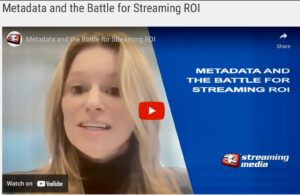Chris Pfaff moderated a virtual session – ‘Know Your Audience: How to Use Data to Raise ROI’ – during the Streaming Media Connect event, on November 15, 2023, featuring Daniel Trotta, from Warner Bros. Discovery; Paul Erickson, from Erickson Insights; Bethany Atchison, from Vevo, and Alan Wolk, from TVREV.

You can watch the entire session at:
https://www.youtube.com/watch?v=gPjmikYJJwI
See two posts from StreamingMedia.com below, by Tyler Nesler – ‘Metadata and the Battle for Streaming ROI’ on December 18, 2023 and ‘How AI Helps Solve Streaming Content Monetization’ on December 11, 2023 – with video excerpts.
Metadata and the Battle for Streaming ROI
By Tyler Nesler
December 18, 2023
Whether your game is FAST, AVOD, SVOD, hybrid, or premium or longtail content, leveraging metadata intelligently is a critical component of monetizing your offerings. Chris Pfaff, CEO, Chris Pfaff Tech Media, Producers Guild of America (PGA), VR AR Association (VRARA), discusses this topic with Paul Erickson, Founder and Principal, Erickson Strategy & Insights, Bethany Atchison, VP, Distribution Partner Management, Vevo, Daniel Trotta, Product Manager, Content Engagement & Monetization, Warner Bros Discovery, and Alan Wolk, Co-Founder/Lead Analyst, TVREV in this clip from Streaming Media Connect 2023.
Pfaff notes that a major topic right now in the streaming industry is the importance of metadata for receiving the best possible ROI. “This is a big, big topic right now as streamers, large and small are trying to find revenue,” he says. “And how are they going to do that?” He asks Erickson about his thoughts on the situation.
“I think metadata is absolutely key, in my opinion, to multiple elements that either directly or indirectly tie to ROI,” Erickson says. “And so when we think about sustaining engagement, which is fundamental to retention and monetization, it’s directly connected to personalization and search and recommendation. If we think about how efficiently you can target and address specific audiences with your advertising, that specificity is aided tremendously by the metadata that helps advertisers understand the nuances of that audience they’re trying to hit. There’s a lot of value [that can be] reaped by those parties who can effectively enhance and enrich metadata, typically using AI…and particularly when it comes to equalizing the level of metadata quality and richness in diverse libraries that may be consistent or that may consist of new and legacy content perhaps from different sources such as what you might have in a FAST channel.”
Erickson also points out that metadata can help to better target the “specific nuances of portions of your content portfolio that are not performing well with your audience and give you some insight into why, depending on the richness and quality of that metadata. And thus, it can help you optimize your existing content portfolio and inform your future content acquisition strategy.”
Pfaff says, “Basically, you’re saying that metadata is really the linchpin. It’s the DNA of everything.”
Erickson says good metadata is table stakes, but “rich metadata is potentially a force multiplier for overall service ROI if you leverage it correctly.”
Pfaff says to Atchison, “I think last year you were really responsible for creating the FAST Channel strategy for Vevo. Talk a little bit about that and how you’re using data to amplify and pump up that ROI.”
“So for anyone who doesn’t know,” Atchinson says, “Vevo is the world’s leading music video network. We have over 800,000 music videos in our catalog across a variety of decades across genres. So organizing our data is really important to keep track of all of that content.” She emphasizes that clean metadata is essential in order to efficiently organize and optimize information. “We have a programming team that uses their expertise to program each of our individual fast channels, but they need to leverage AI and data to really comb through all of that and surface everything to them because there’s just so much content to go through. So for us, it’s really tantamount to the success of our channels.”
Pfaff says to Trotta, “Let’s talk about channels with Warner Brothers Discovery. Talk about how you’re sifting through the metadata sands to enhance all things revenue.”
Trotta focuses on the “pause ad” feature available on many platforms as a good use case of metadata for exceptional ROI. “Say you’re watching something like Breaking Bad and you pause on one of those moments in Breaking Bad where maybe you don’t want somebody walking into the room. You also don’t want an advertiser’s ad to pop up over that. I know streaming services are working towards this metadata that runs through the episode to show you when areas are safe and when they are not. It allows you to take this ad format and distribute it across more of your programming hours than you otherwise would have. So that’s ROI. That’s money in your pocket right there. And it’s a better viewing experience than dropping this ad where it shouldn’t be.”
Pfaff asks Wolk, “What recently stands out to you in terms of the state of metadata where streamers are battling for engagement and retention?”
Wolk says that a major current issue for utilizing good metadata is the fact that when older popular shows were first digitized, no one really thought about how to tag content consistently. “Like Seinfeld ‘comedy show,’ Seinfeld, ‘funny show.’ And sometimes it’d be in all caps, sometimes it’d be in lowercase,” he says. “It’s really hard to kind of match it up. And so there’s been a lot of work being done. There are companies like IRIS.TV, which have sort of created a content tag that tries to standardize it. But it’s a huge problem with advertising because a lot of times they don’t really know what’s going on. The good news is everybody’s aware of it and is moving to fix it, but it’s way behind what’s available on digital.”
How AI Helps Solve Streaming Content Monetization
By Tyler Nesler
December 11, 2023
Much discussion of AI and streaming relates to streamlining and automating workflows, but how content companies can leverage it to personalize their content and target ads more efficiently, among other monetization strategies, is another question the industry is examining closely.
Chris Pfaff, CEO, Chris Pfaff Tech Media, Producers Guild of America (PGA), VR AR Association (VRARA), dives into the AI streaming monetization question with Bethany Atchison, VP, Distribution Partner Management, Vevo, Daniel Trotta, Product Manager, Content Engagement & Monetization, Warner Bros. Discovery, Alan Wolk, Co-Founder/Lead Analyst, TVREV, and Paul Erickson, Founder and Principal, Erickson Strategy & Insights in this clip from Streaming Media Connect 2023.
“I’m just curious from all of your perspectives where you see AI working,” Pfaff says. He asks Atchison to give her thoughts on the situation.
“We generally use AI for combing through all of the mountains of data we have across our different channels and platforms,” Atchinson says. “We definitely believe in the importance of the human element in creating our programs on our channels. So we’re really not leveraging that to create the content, but we are using it to make sure that everything is being surfaced, and that also enables us to surface new artists that might not be top of mind for everyone watching, but because the data is organized so cleanly, we’re able to find rising artists who are new in hip hop and put them on our Vevo hip hop channel and give them a platform and an opportunity to be seen in a CTV environment.”
Pfaff says to Trotta, “I’m sure you’ve got some homegrown AI that you use in addition to other major vendors. Talk about some of your war stories in trying to implement AI to ‘know thy audience’ better.”
“A lot of what you see on a streaming homepage is personalized to you and your past viewing behavior and what similar viewers to you have viewed in the past,” Trotta says. “The human element there that is still really vital is pointing the algorithm in the correct direction. So that’s setting the key input and key output metrics and determining [if you] are going to optimize for the most active viewers you can get on your service in a given day? Are you going to optimize for the most viewing hours you can get on your service in a given day? Are you going to optimize for the frequency with which users come back in a month? These are all [elements] that get sped through the pipeline that ultimately becomes what the user sees. But that’s the fundamental question to kick everything off each time.”
Pfaff says, “I think that, certainly, this will get better and better, but you’ve got to do that for millions of viewers and devices as well.” He next asks Wolk how he and TVREV view AI and how it aids service providers.
“I think AI is going to be a huge game changer,” Wolk says. “We’re already seeing it now…the thing that we always talk about is how nobody wants to run their funny commercial during the funeral scene of a show, and it’s been very hard to identify that…and now they’re able to do that to understand the emotions and even other things, like if I’m Cadillac and Matthew McConaughey is in a scene, I want to run my ad there too, so it creates a nice synergy. And then even understanding what sorts of shows viewers like and being able to personalize their feeds. It’s just such an exciting time, and the ability to do this is just going to be incredible.”
Pfaff asks Erickson, “I’m just curious, in terms of things like ad frequency and ad fatigue…how that needs to be solved and what you’re seeing in terms of solutions.”
“Well, certainly I think AI will help in that, but my thoughts on ad overload and poor targeting…they’re always going to be a net negative for engaging or retention, which obviously impacts your ROI over time,” Erickson says. “My thought on this [is that] content is that the lifeblood of any video operation, whether that’s traditional broadcast, the streaming services, Free Ad-Supported Television (FAST) channels…it can make or break the economics of your service. The right content brings people in, keeps them there, and brings them back. But running out of content leads to them to churning. Spending too much on that content, no matter how good and relevant will put you upside down ROI-wise. So today, I think we’re finally seeing serious judicious review of content spending when it comes to acquisitions and commissions to ensure that overall content budgets are being used efficiently and profitably.”
He notes that ad frequency and poor demographic data are particular issues for FAST. “Hopefully, it’s going to be improved, and it is improving.” He says that ultimately, it remains very important “To make sure that you are spending your budget judiciously on the right kinds of content, whether that’s an original commission or licensing it…I think that will still be fundamental to your service’s success.”

